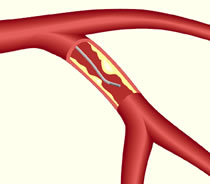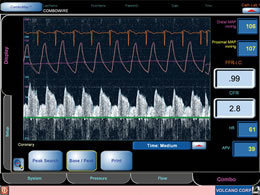
FloWire® Doppler
Guide Wire image, courtesy Volcano Corporation |
What
is FFR?
Fractional Flow Reserve, or FFR, is
a guide wire-based procedure that can accurately measure
blood pressure
and flow through a specific
part of the coronary artery. FFR is done through a standard diagnostic
catheter at the time of a coronary angiogram (a.k.a. cardiac catheterization).
The measurement of Fractional Flow Reserve has been shown useful
in assessing whether or not to perform angioplasty or stenting
on "intermediate" blockages. The
point of opening up narrowings or blockages in the coronary arteries
is to increase blood flow to the heart. But a number
of studies have shown that if a "functional
measurement", such as Fractional Flow Reserve,
shows that the flow is not significantly obstructed,
the blockage or lesion does not need to be revascularized
(angioplasty) and the patient can be treated safely
with medical therapy.
How Can FFR Affect Treatment
of the Patient?
For example, a lesion measures 50% on the coronary angiogram. The patient hasn't
experienced symptoms, like angina or chest pain. Nonetheless the lesion can
be seen clearly on the TV monitor in the cath lab. The cardiologist (and patient)
may be tempted to stent the lesion (a.k.a. the stenosis) for any number of
reasons. After all, there's a blockage there -- why not take care of it? This
reaction has been referred to in the medical literature as the "oculo-stenotic
reflex" -- you see a stenosis, so you open it up and stent it. However,
a few minutes of measurement with a special guide wire may reveal that an intervention
won't have a significant impact on this particular blockage. Being able to
better select cases not only saves health care costs, but contributes to more
appropriate patient care.
Recent studies, such as the COURAGE
trial, have re-emphasized what all current medical guidelines
recommend: that for low risk patients, even those experiencing
angina, optimal medical therapy should be the initial treatment.
For those patients whose disease progresses, or for whom
chest pain is not alleviated, revascularization, either
through angioplasty and stenting or surgery, should be
performed. Fractional Flow Reserve can be a significant
tool to help physicians in deciding whether to intervene
or not.
Furthermore, studies such as DEFER show
that patients who have been screened out of angioplasty
by using FFR have not experienced an increase in adverse
outcomes. And in these studies, two-thirds of the patients
were judged not to need an intervention with balloons or
stents. More recently the FAME study
showed that FFR allowed elimination of a third of the lesions
that might have been stented using angiography alone, with
better outcomes for patients

ComboMap® Pressure
and Flow System image,
courtesy Volcano Corporation |
How Does Fractional
Flow Reserve Work?
A very thin guide wire is inserted through a standard 4F
or 5F diagnostic catheter during an angiogram. Because
of the smaller size catheter necessary, this can
be done as an outpatient procedure.
The special guide wire crosses
the lesion and is able to measure the flow and pressure
of the blood, after infusion of a hyperemic agent, such as adenosine. Results are displayed on a special monitor
(left) along with the "FFR value". Studies have
shown that an FFR value less than 0.75 or 0.80 corresponds
to inducible ischemia, and most likely will require interventional
treatment. Blockages that score above this threshold can
be safely and adequately treated by medical therapy without
the need for angioplasty.
A new physiologic measurement, called iFR or Instant wave-Free Ratio, was recently approved by the FDA for use in coronary stent guidance. iFR does not require the use of adenosine or other hyperemic agent.
Is Fractional Flow Reserve
a New Technology?

FloWire® Doppler Guide Wire photo, courtesy Volcano Corporation |
The concept of measuring the blood flow across a blocked
area or stenosis is as old as coronary angioplasty itself.
The first balloon catheters invented by
Dr. Andreas Gruentzig included a a special lumen (or channel) to measure pressures
at the proximal and distal ends. The waveforms were then displayed on a monitor
in the cath lab. The greater the distance between the two pressures, the greater
the blockage. Dr. Gruentzig would inflate the balloon several times, until
he was able to get the two pressures close to each other,
indicating that the blockage
was now sufficiently open.
But to read the pressures, the
balloon needed an extra lumen, which made the balloon too
large to get through very tight lesions or into smaller
arteries. Lower profile balloons were invented, but they
could not measure pressures, so this concept of measuring
pressures virtually disappeared, to the chagrin of a number
of cardiologists.
Today, however, newer devices
that use Doppler and other technologies allow these measurements
using only a .014" guide wire -- no balloon needed.
 For more information visit our Intravascular Guidance Center. For more information visit our Intravascular Guidance Center.
Reviewed February 2013, Angioplasty.Org staff |